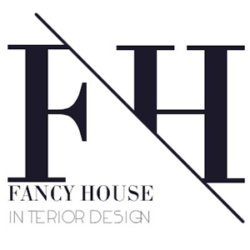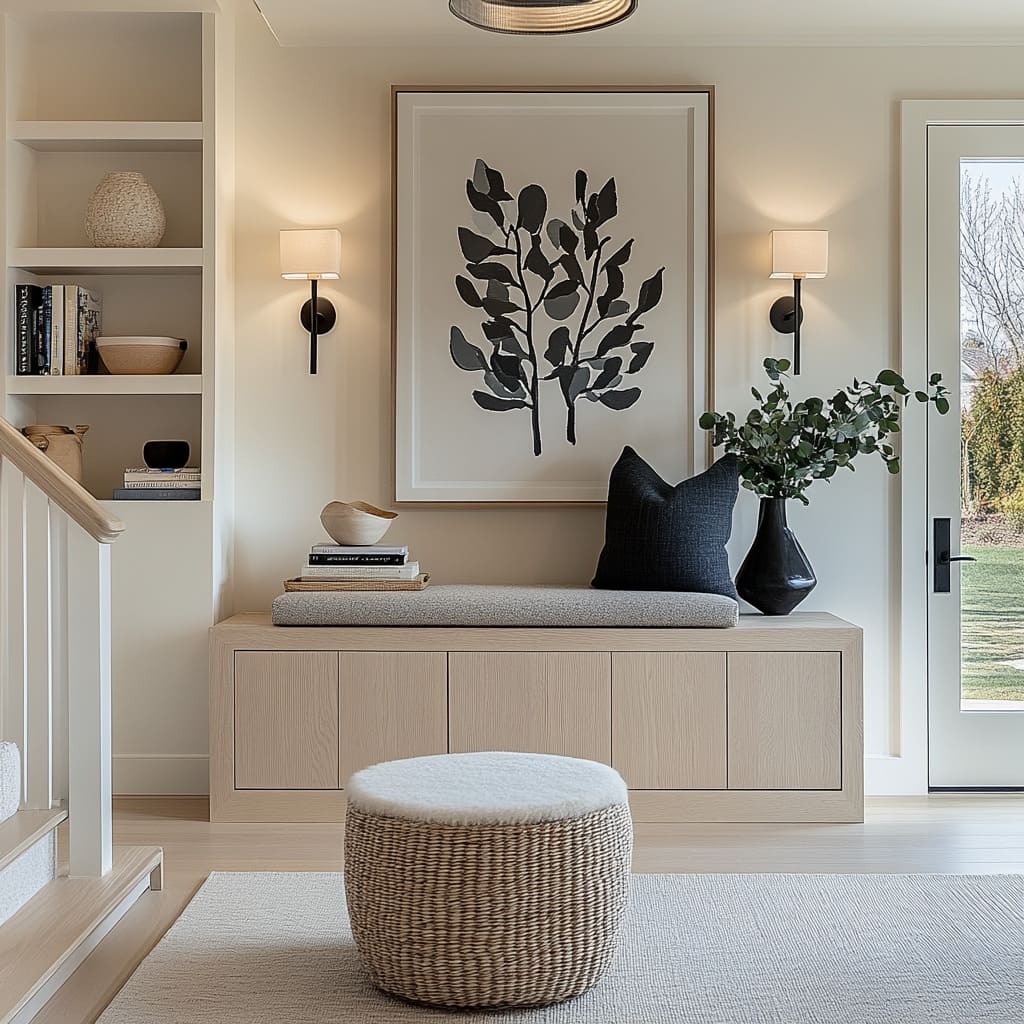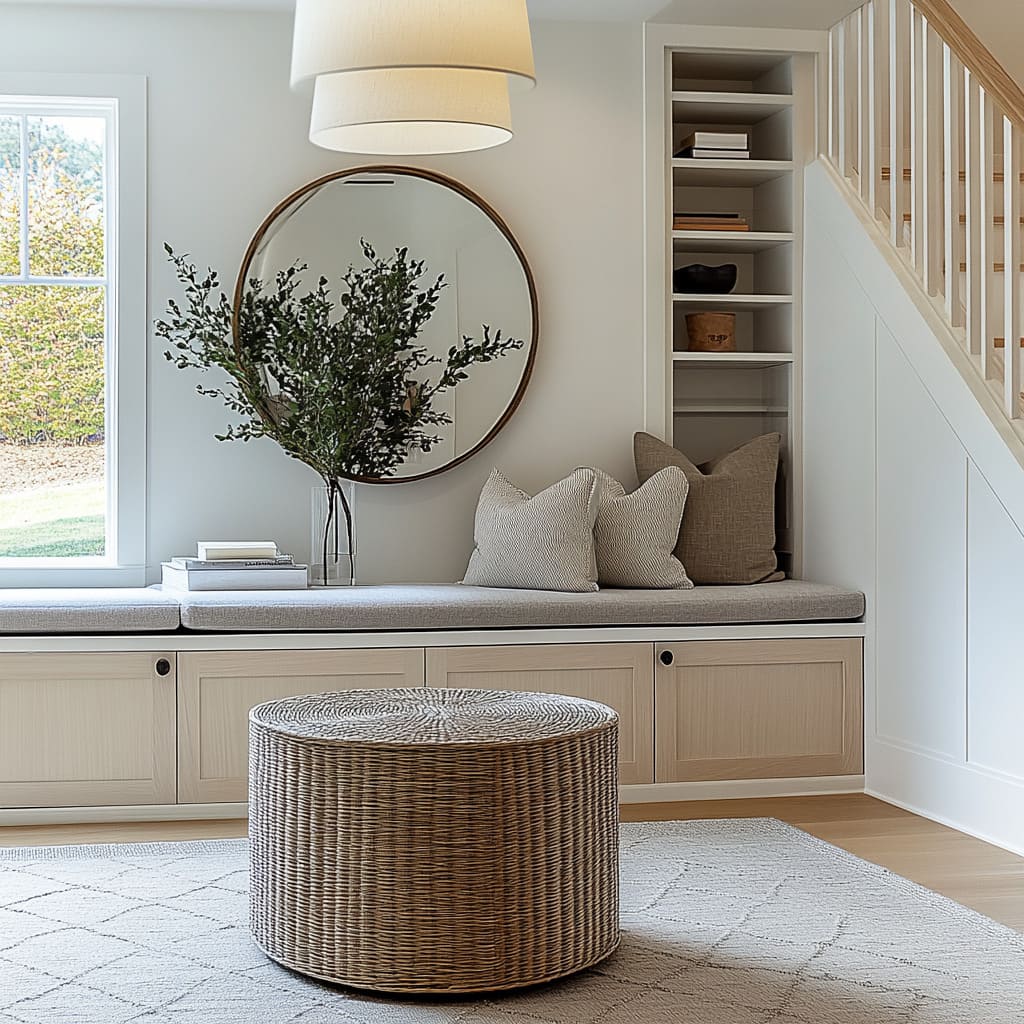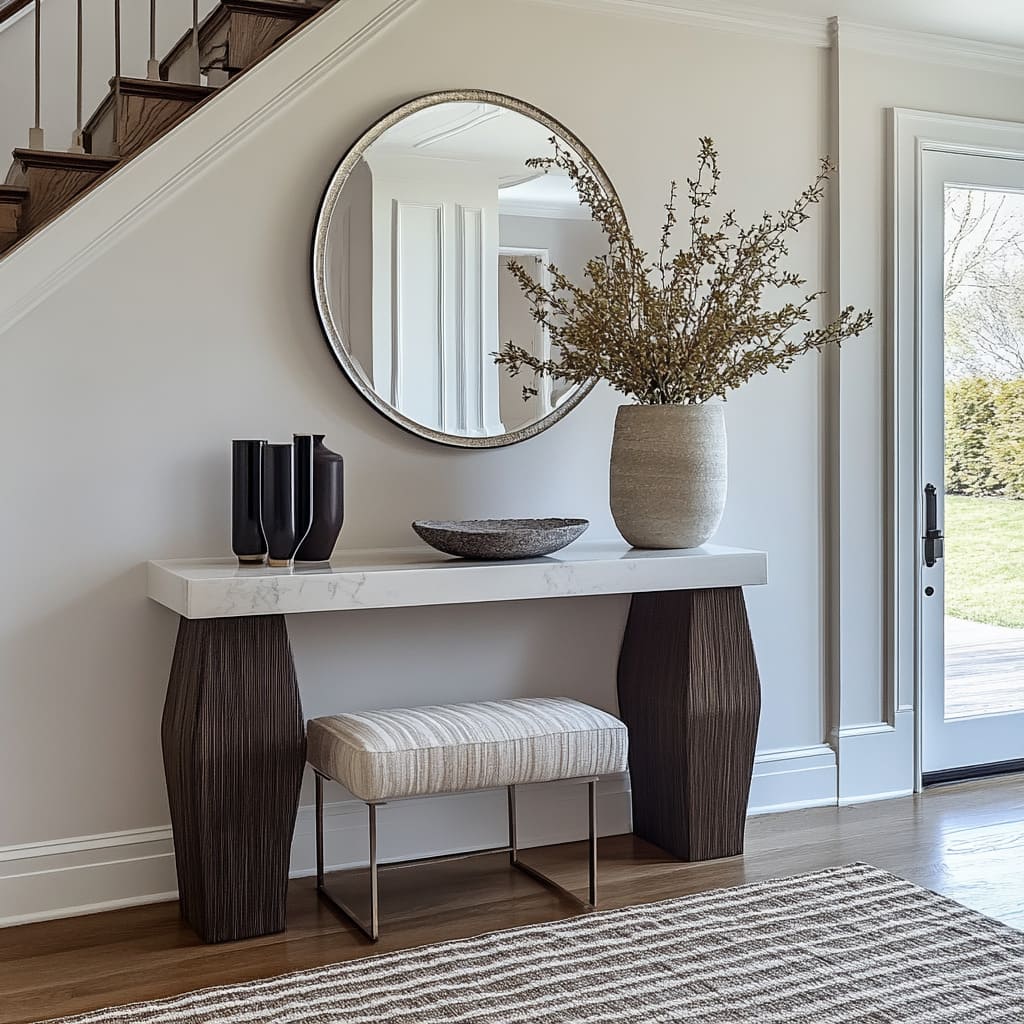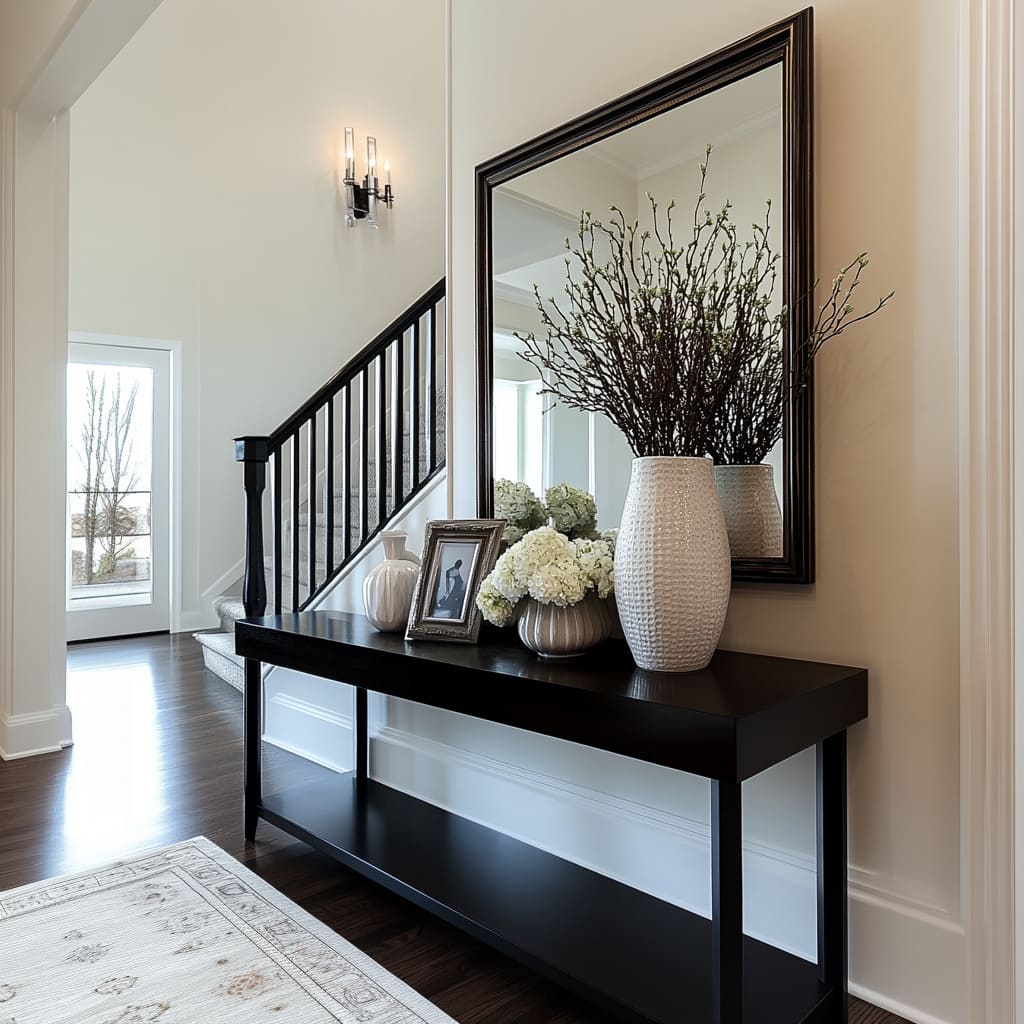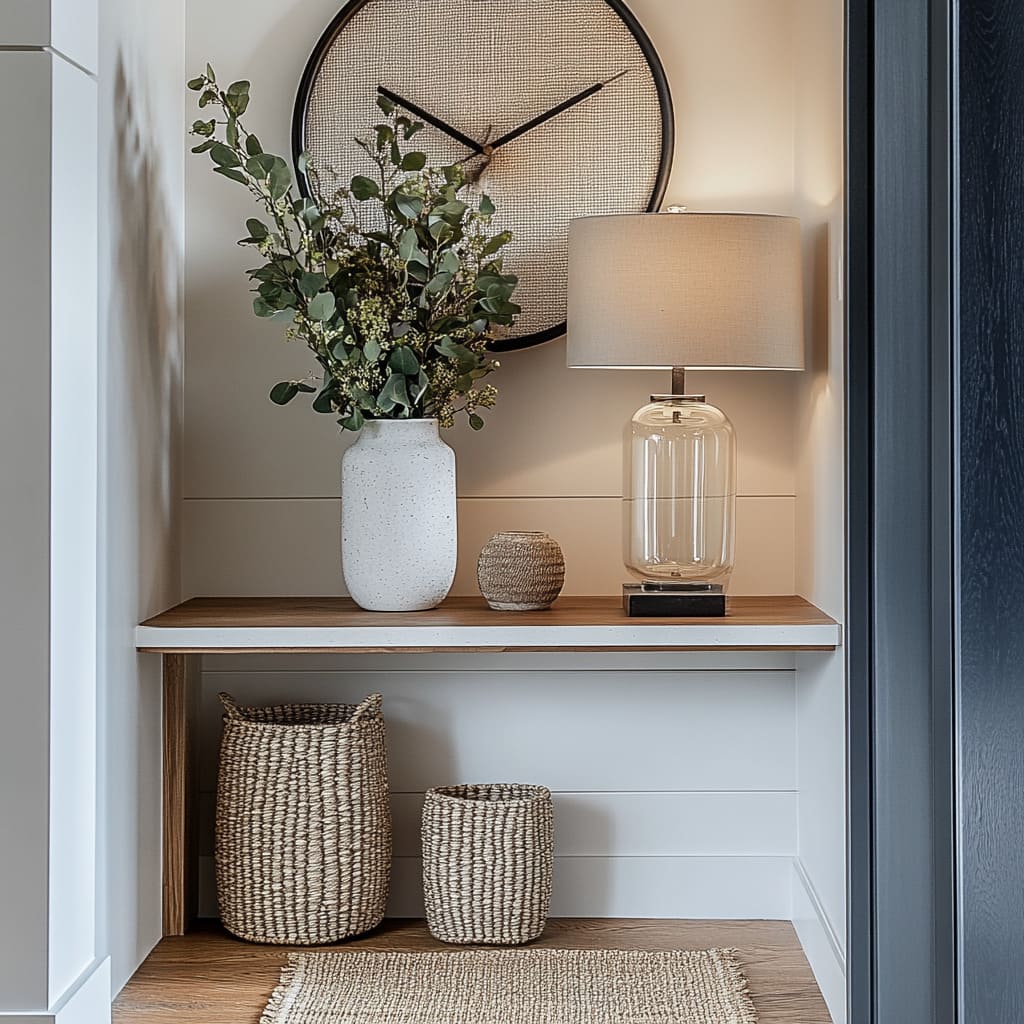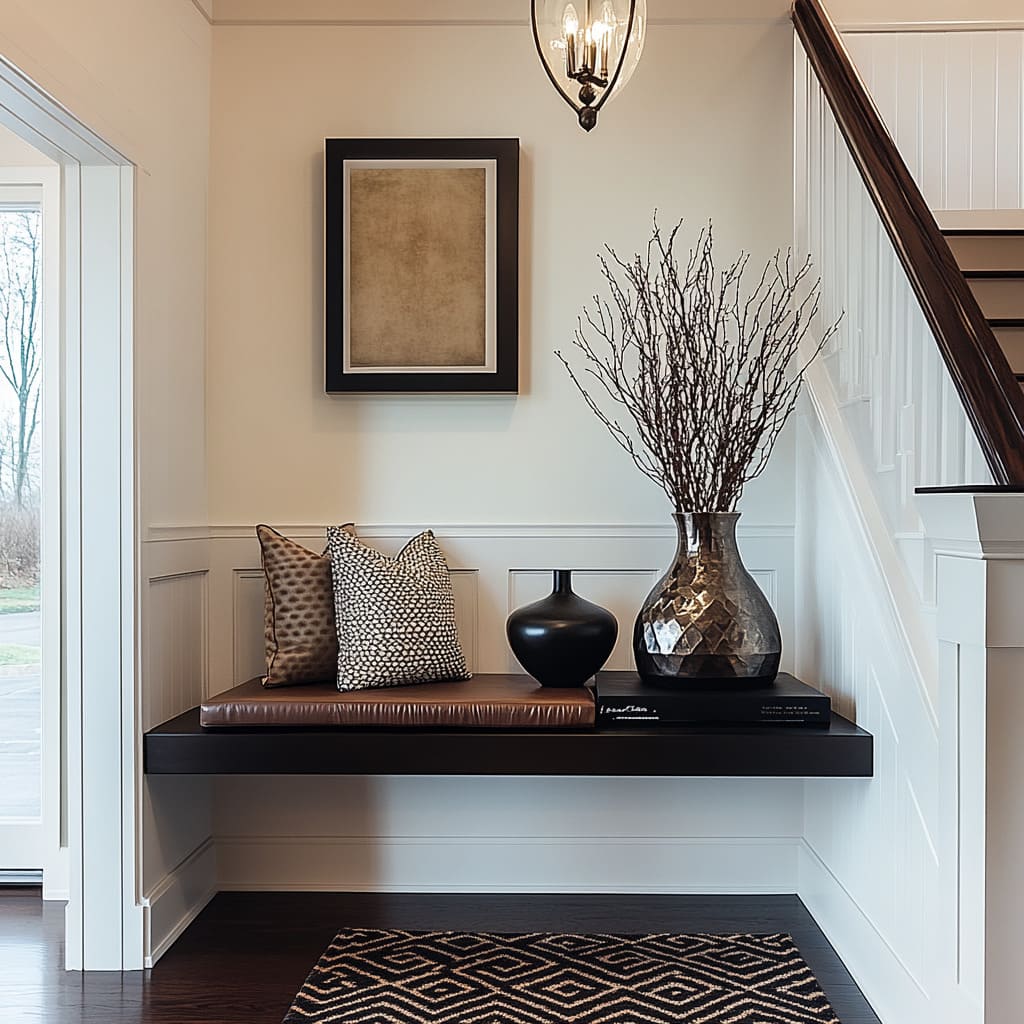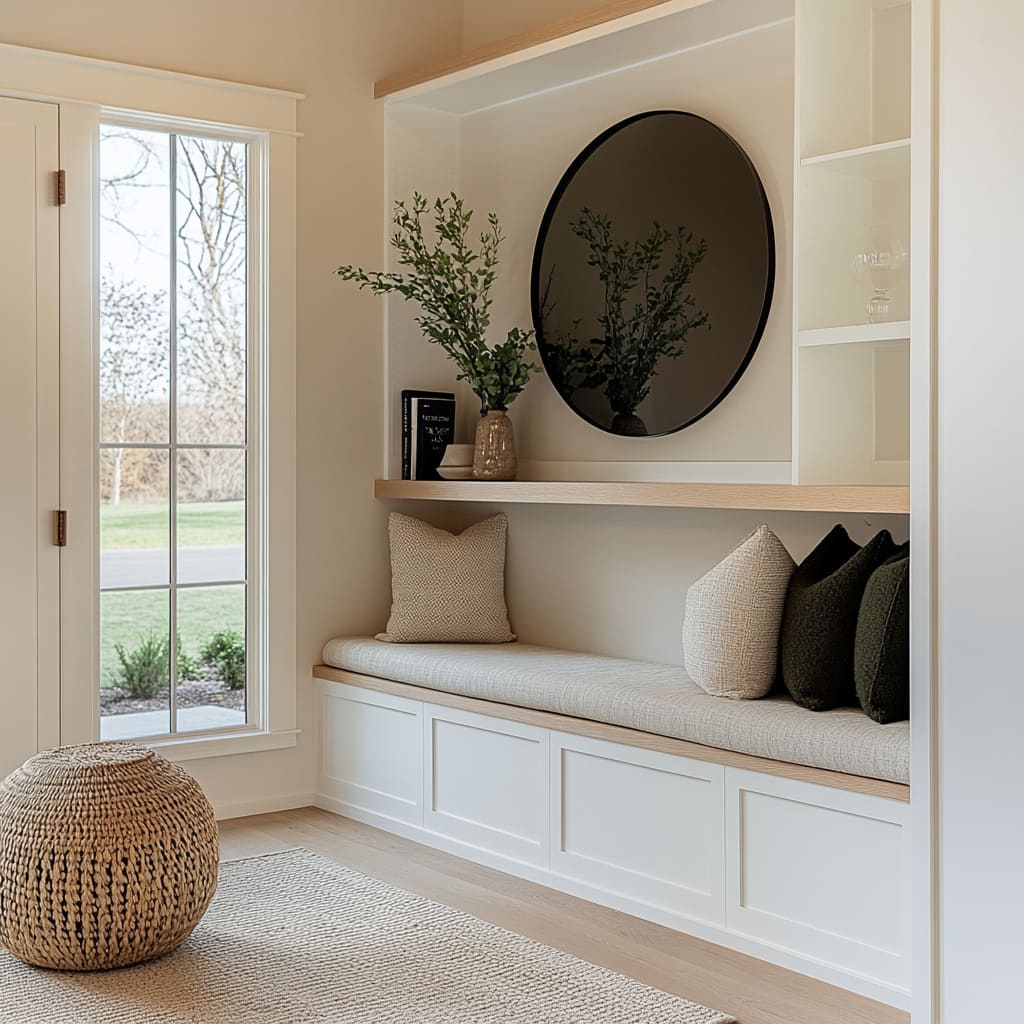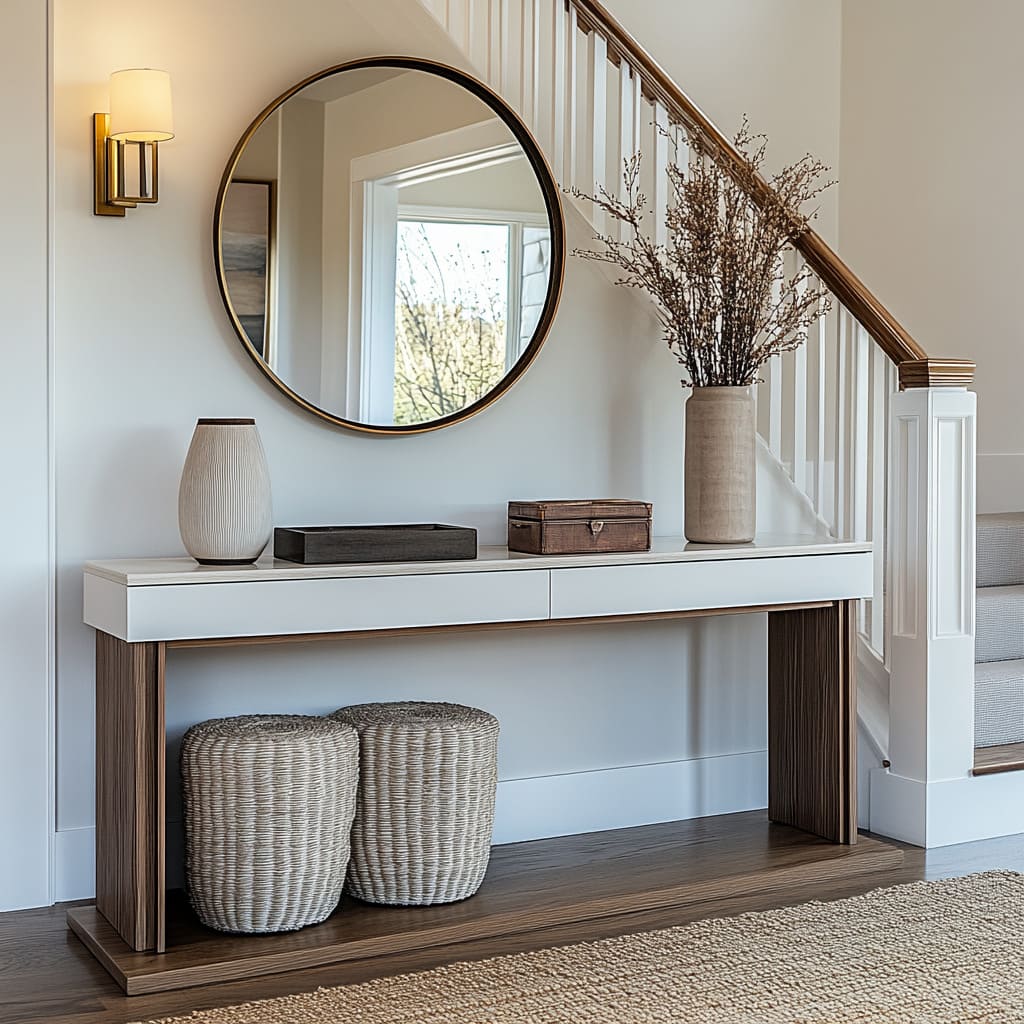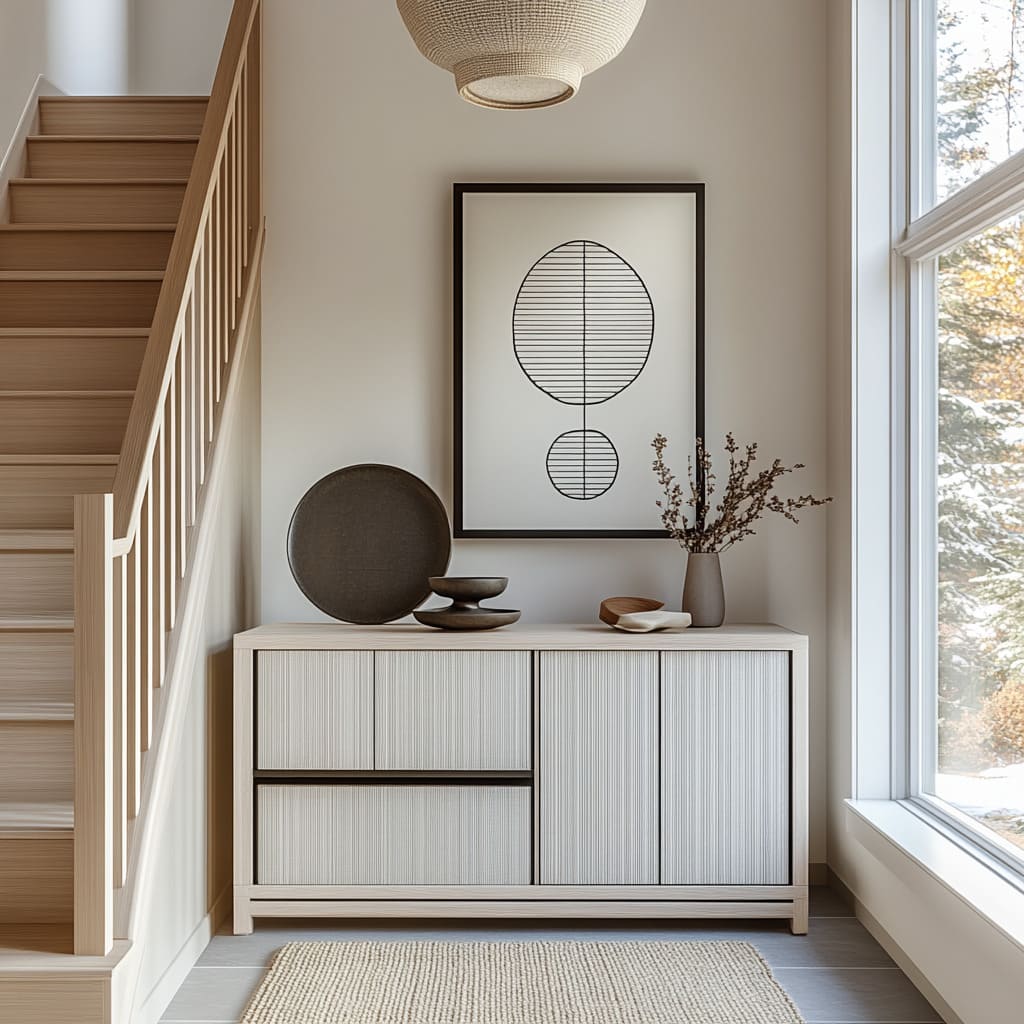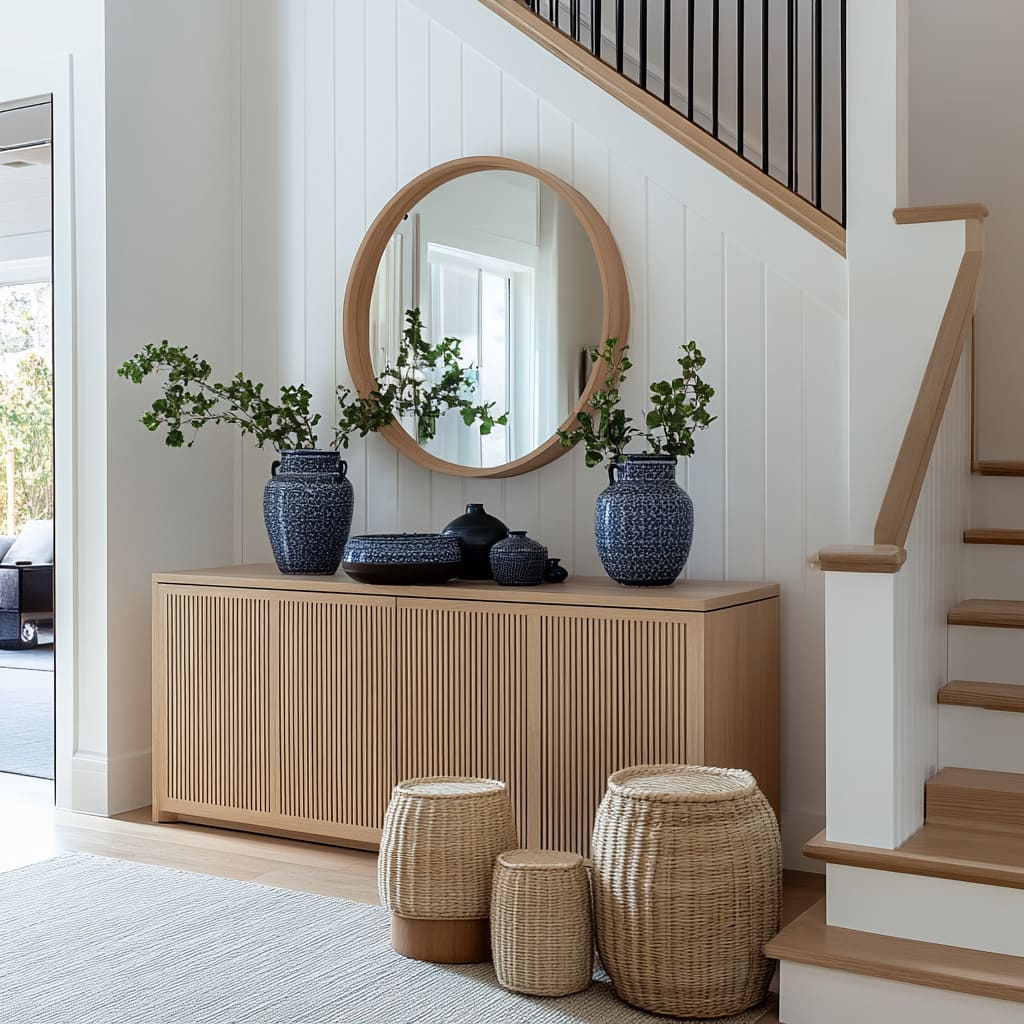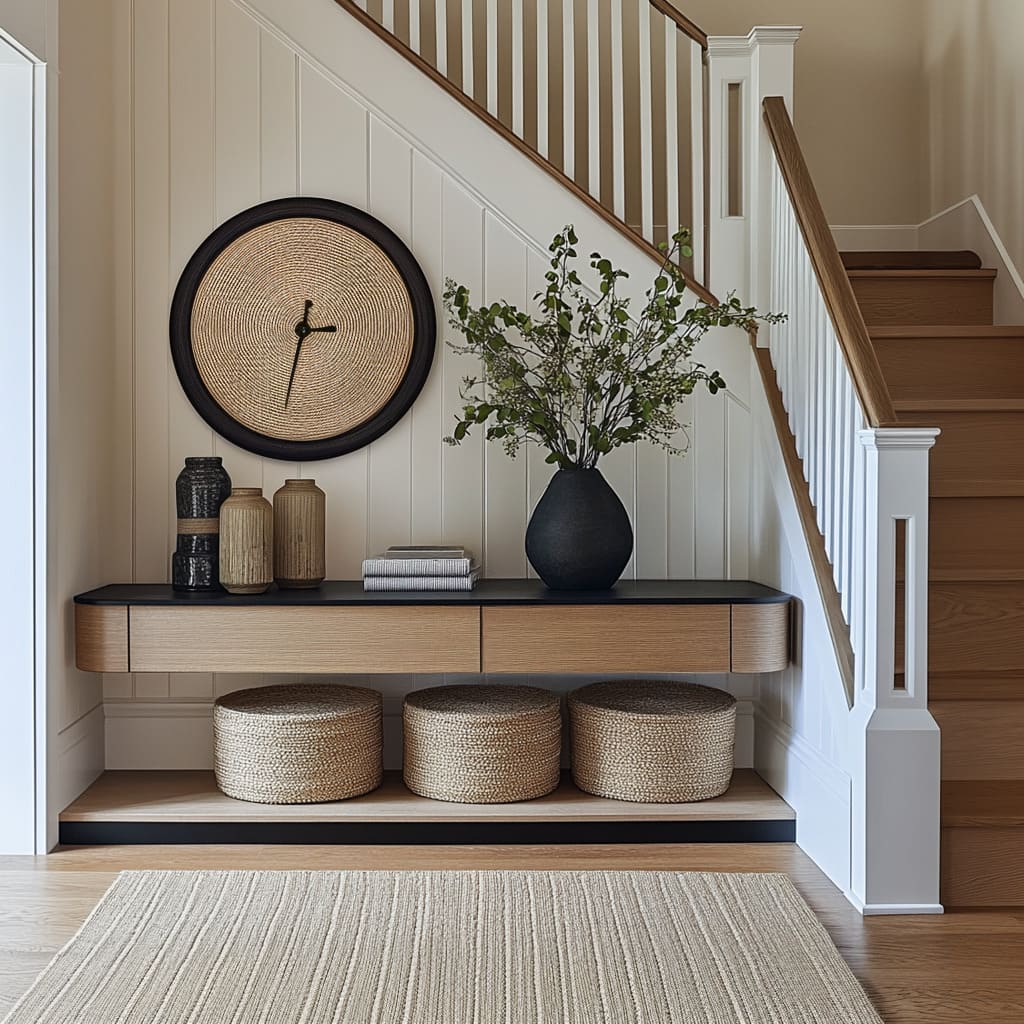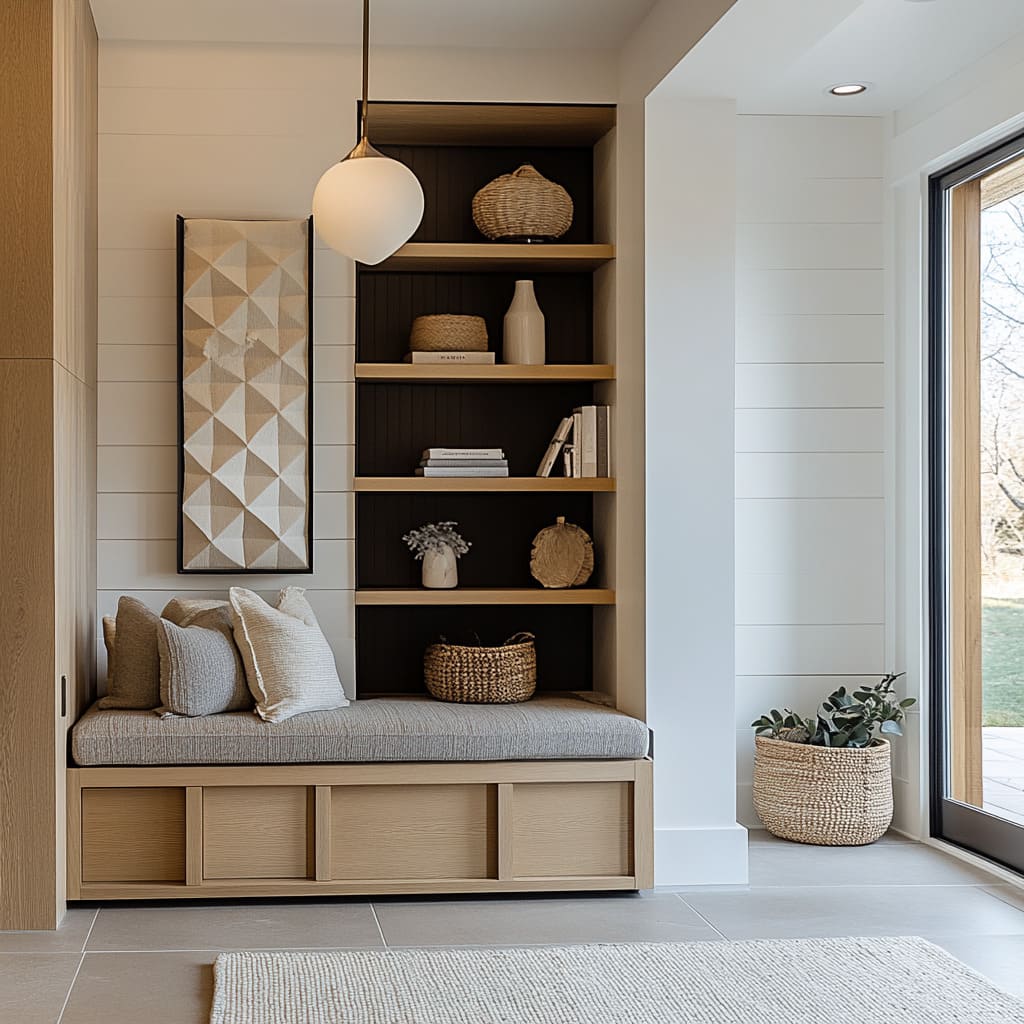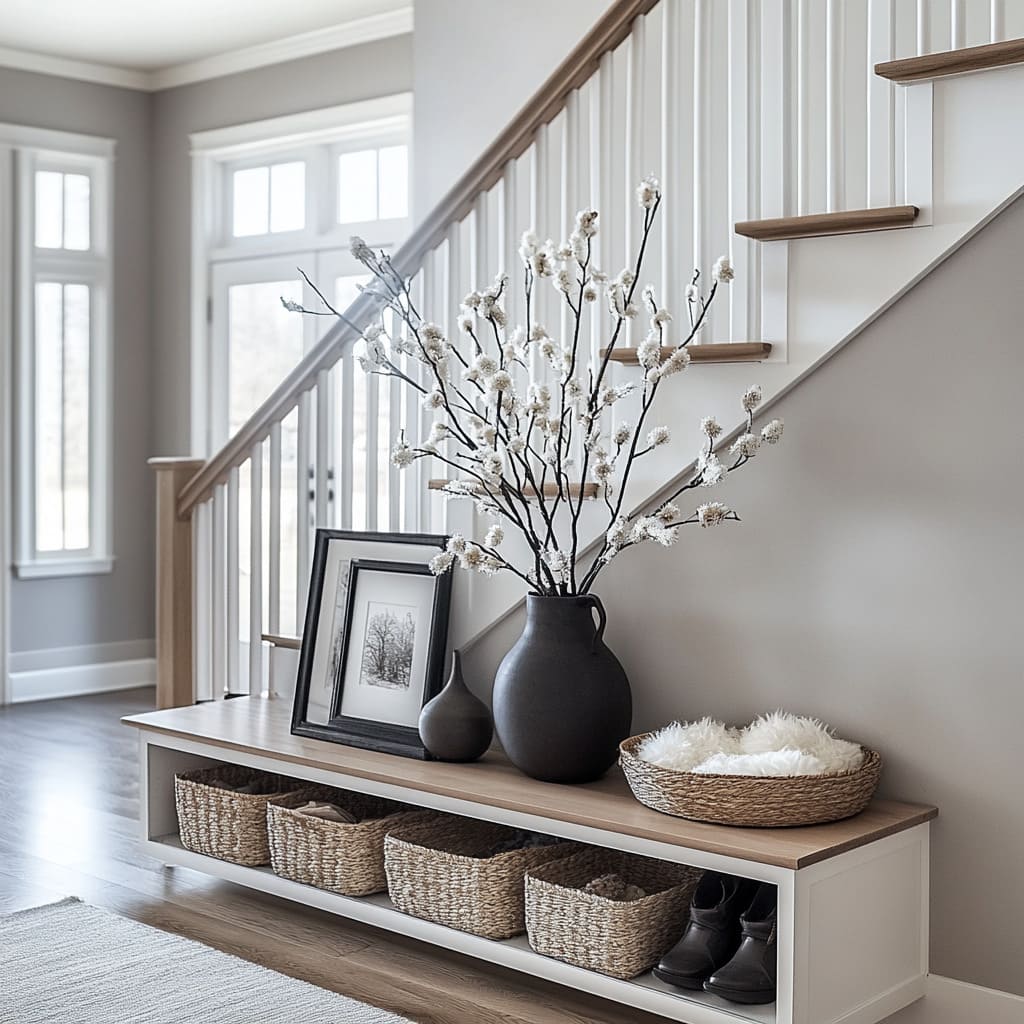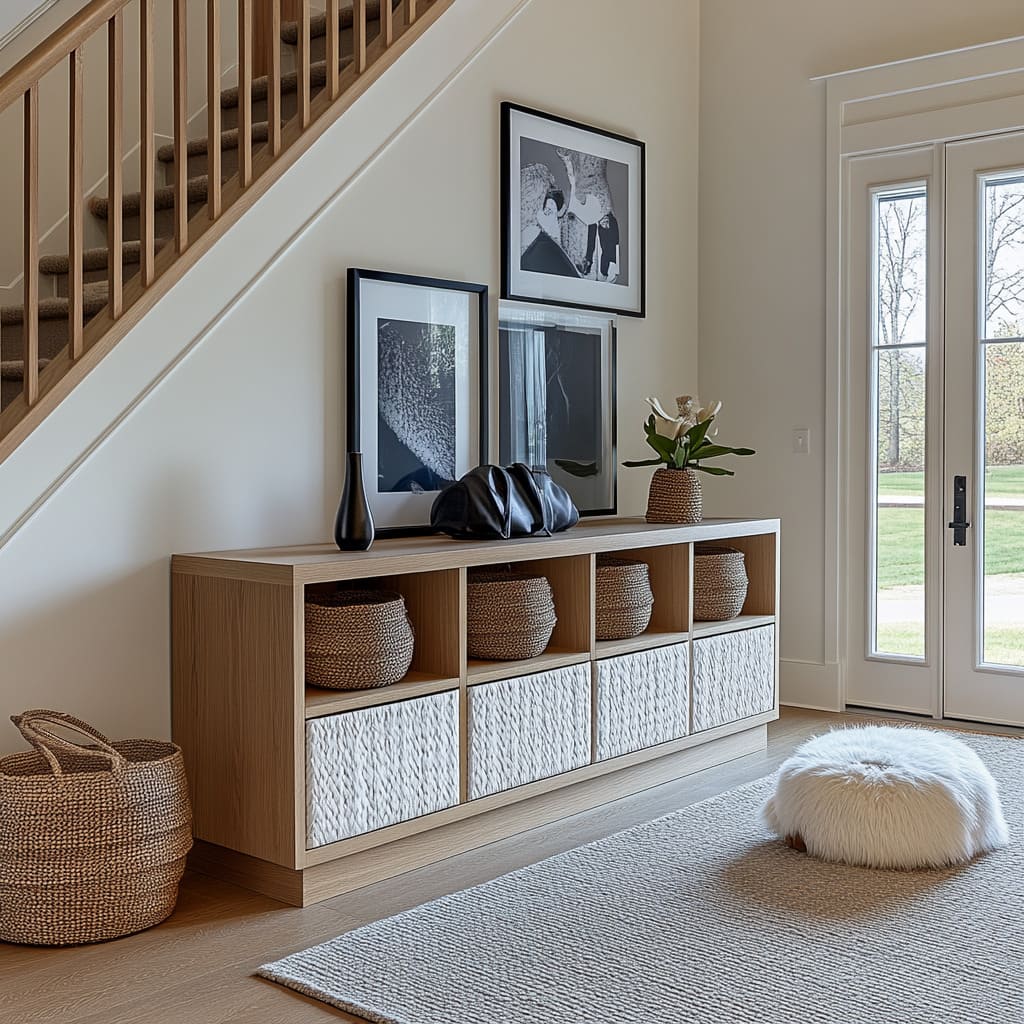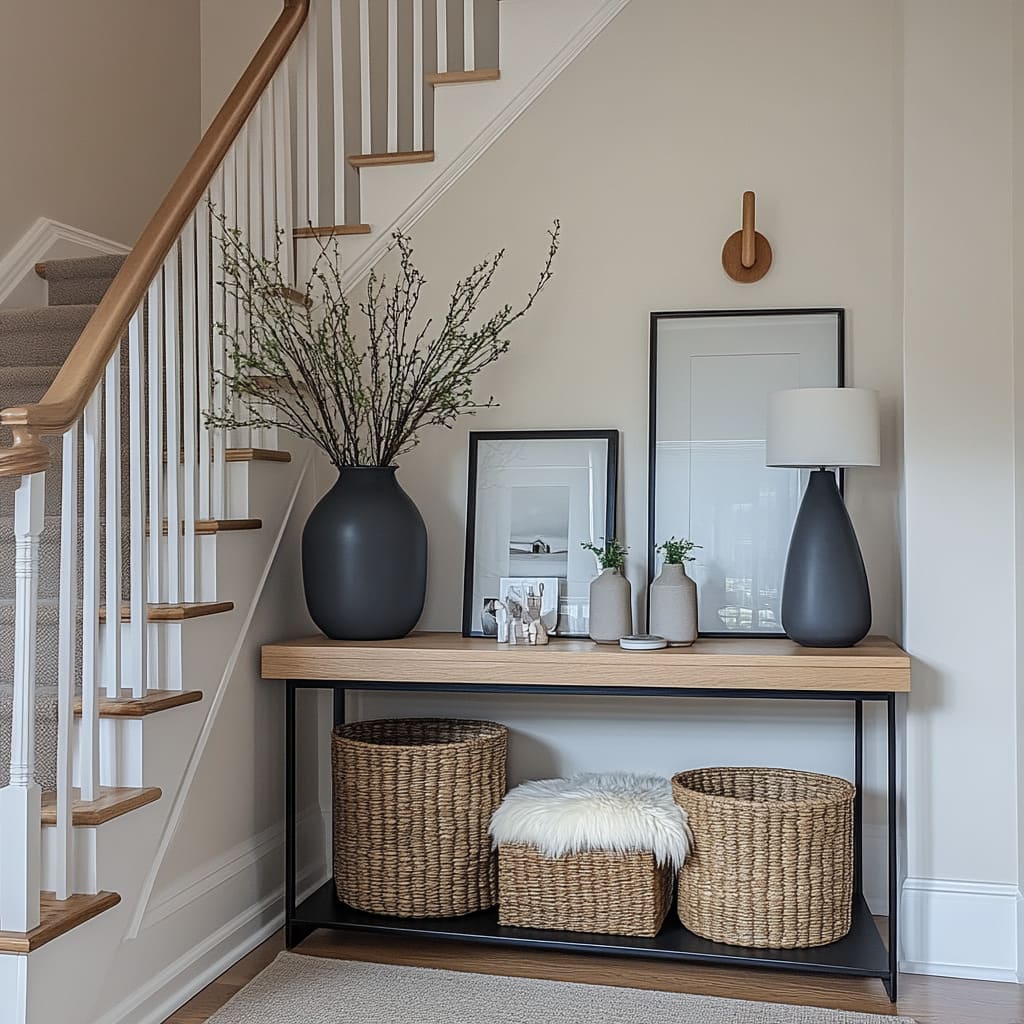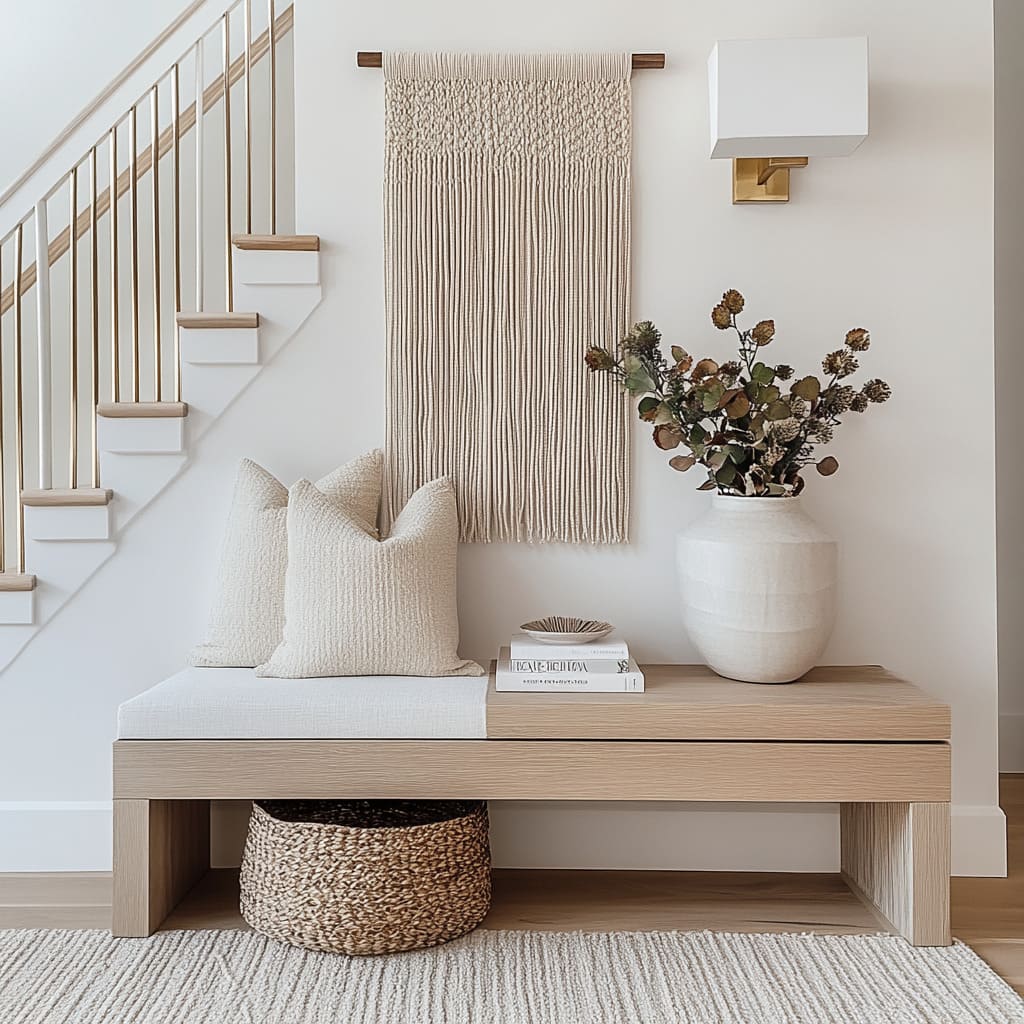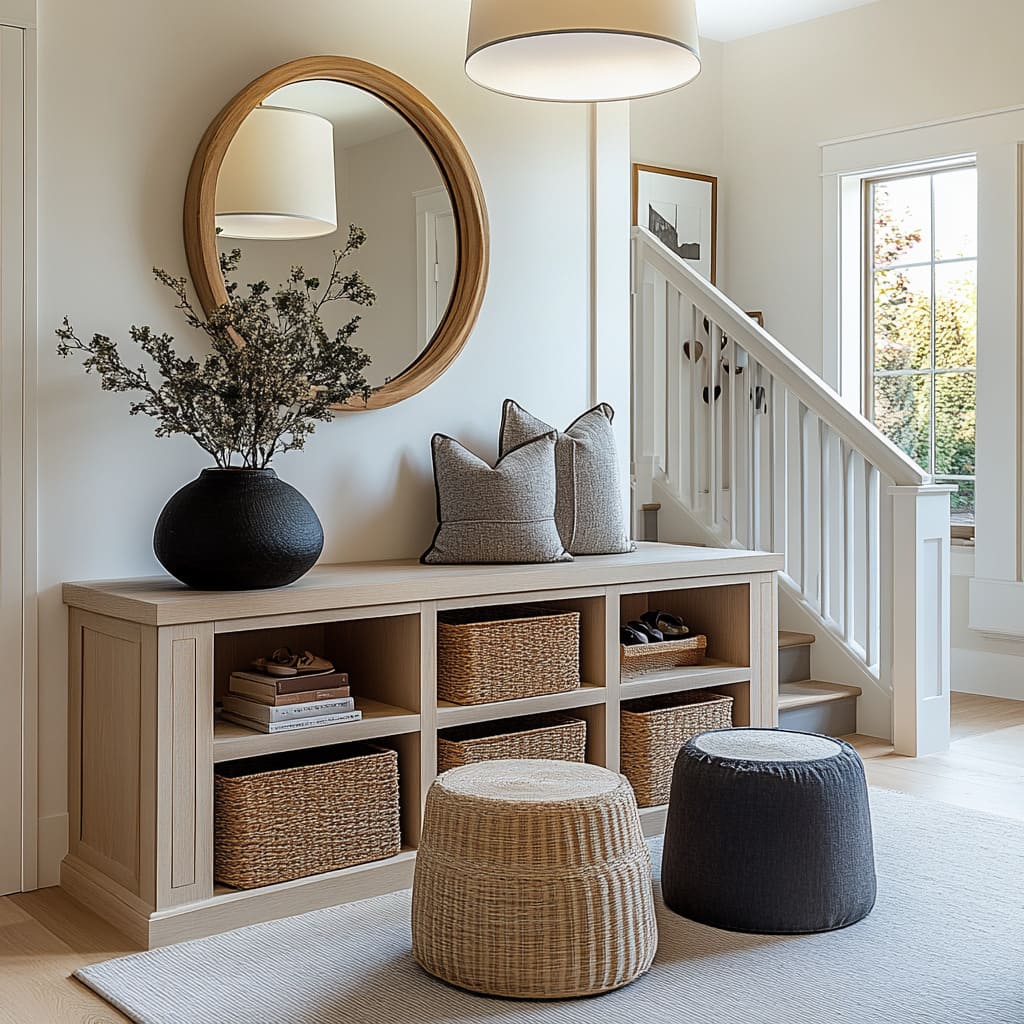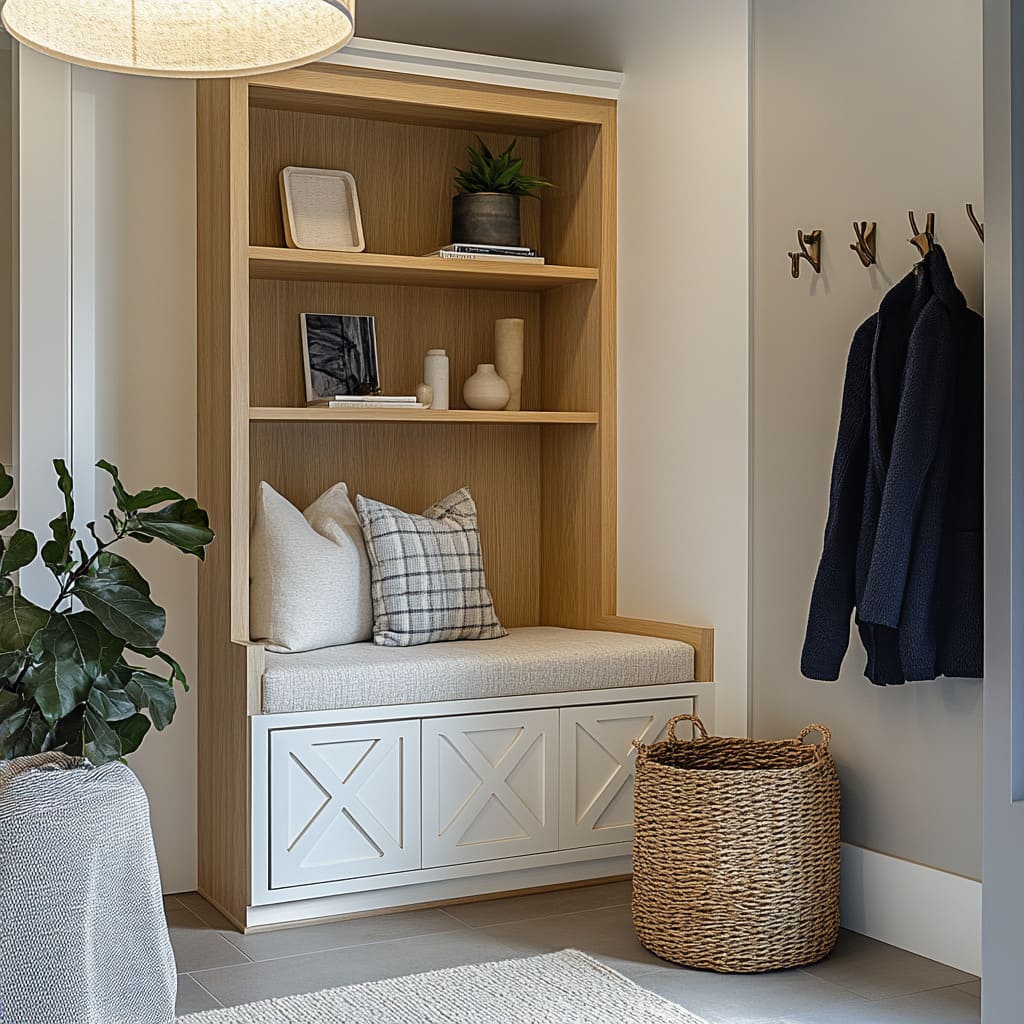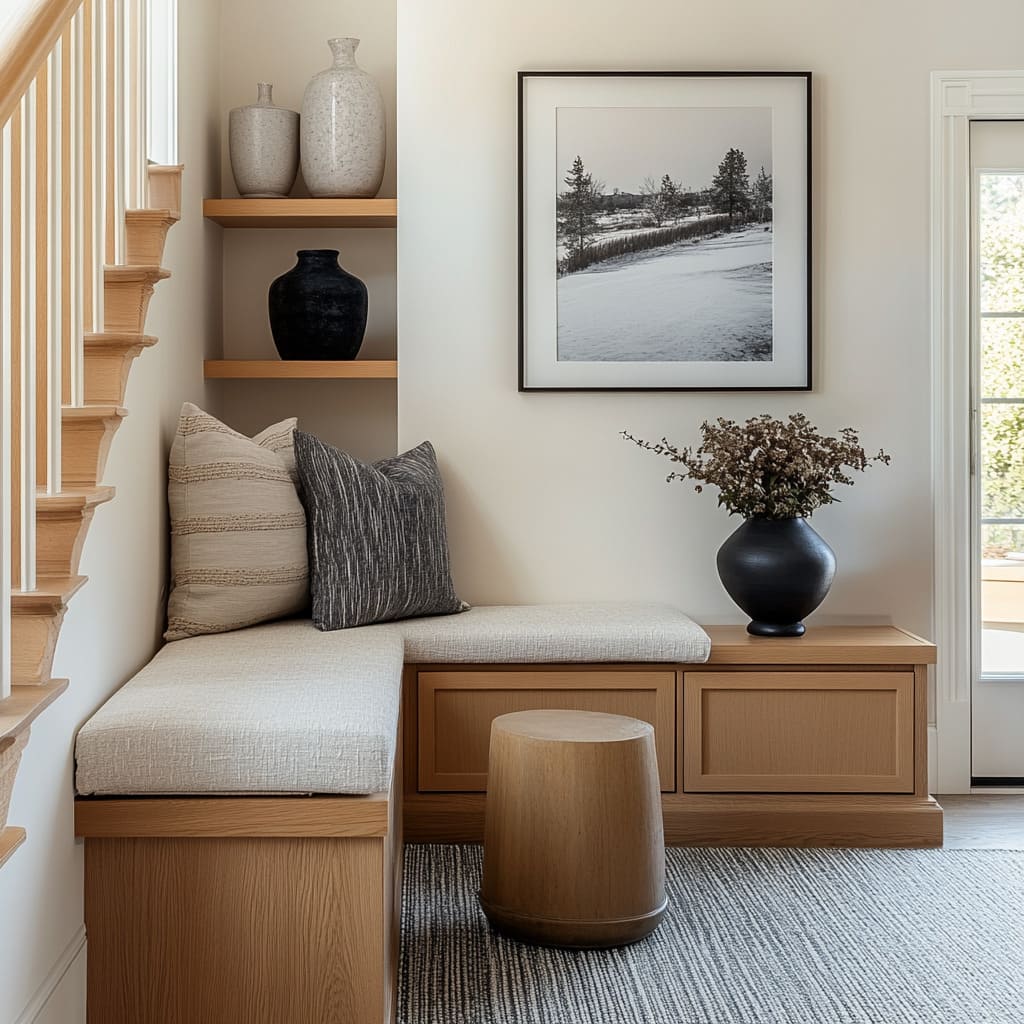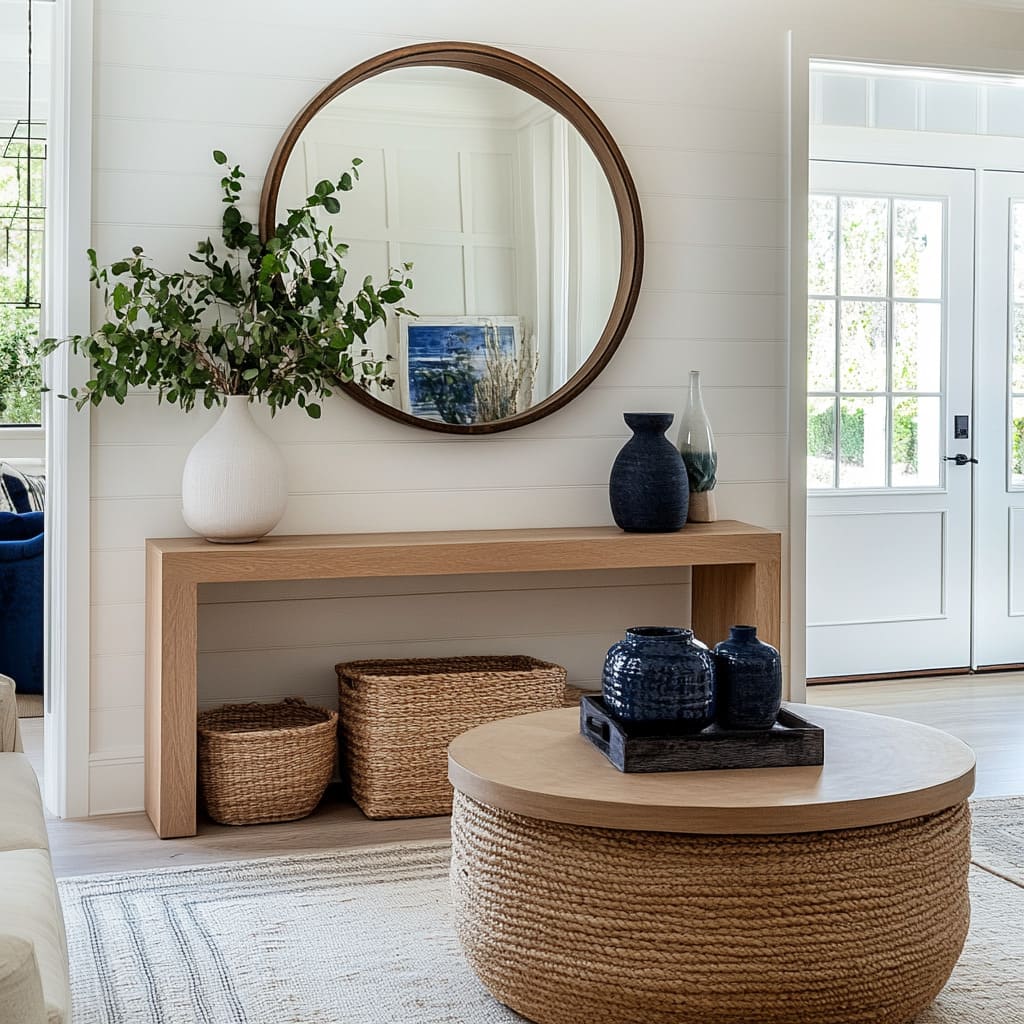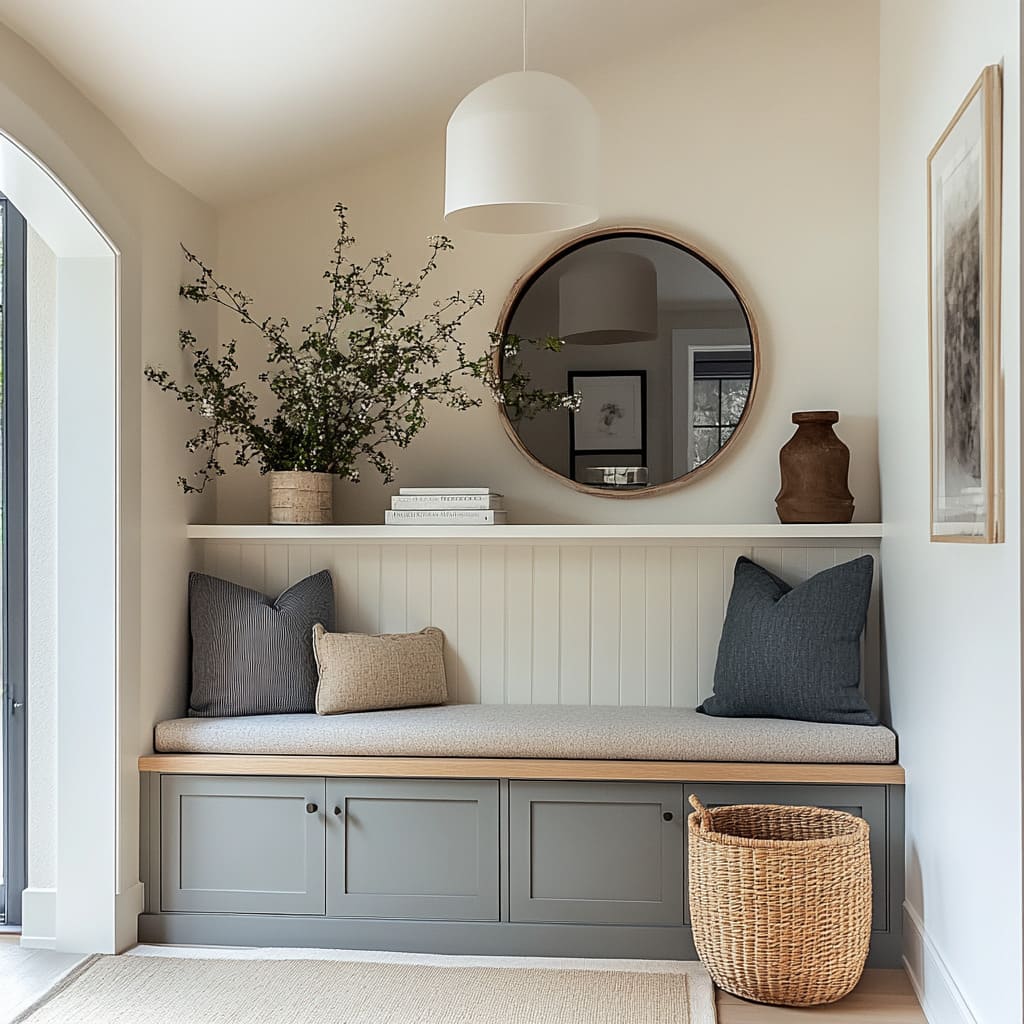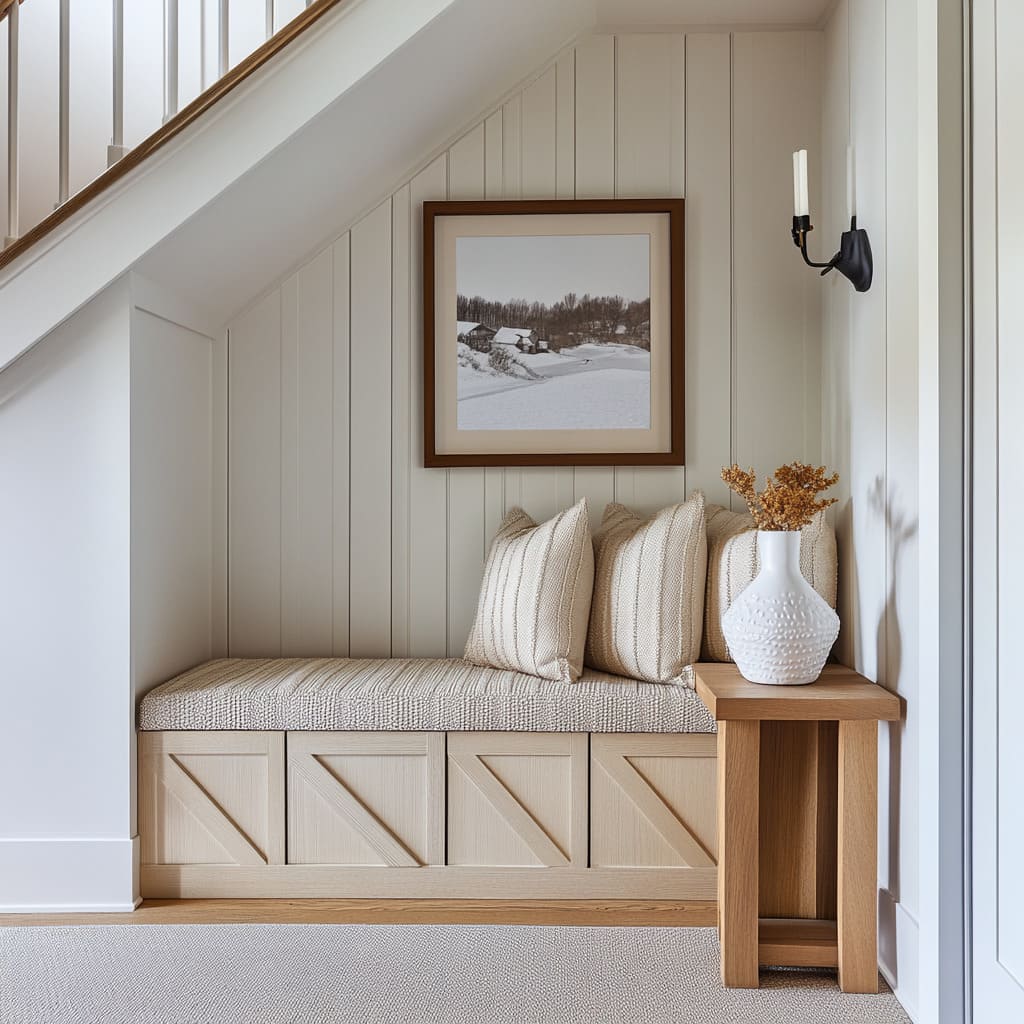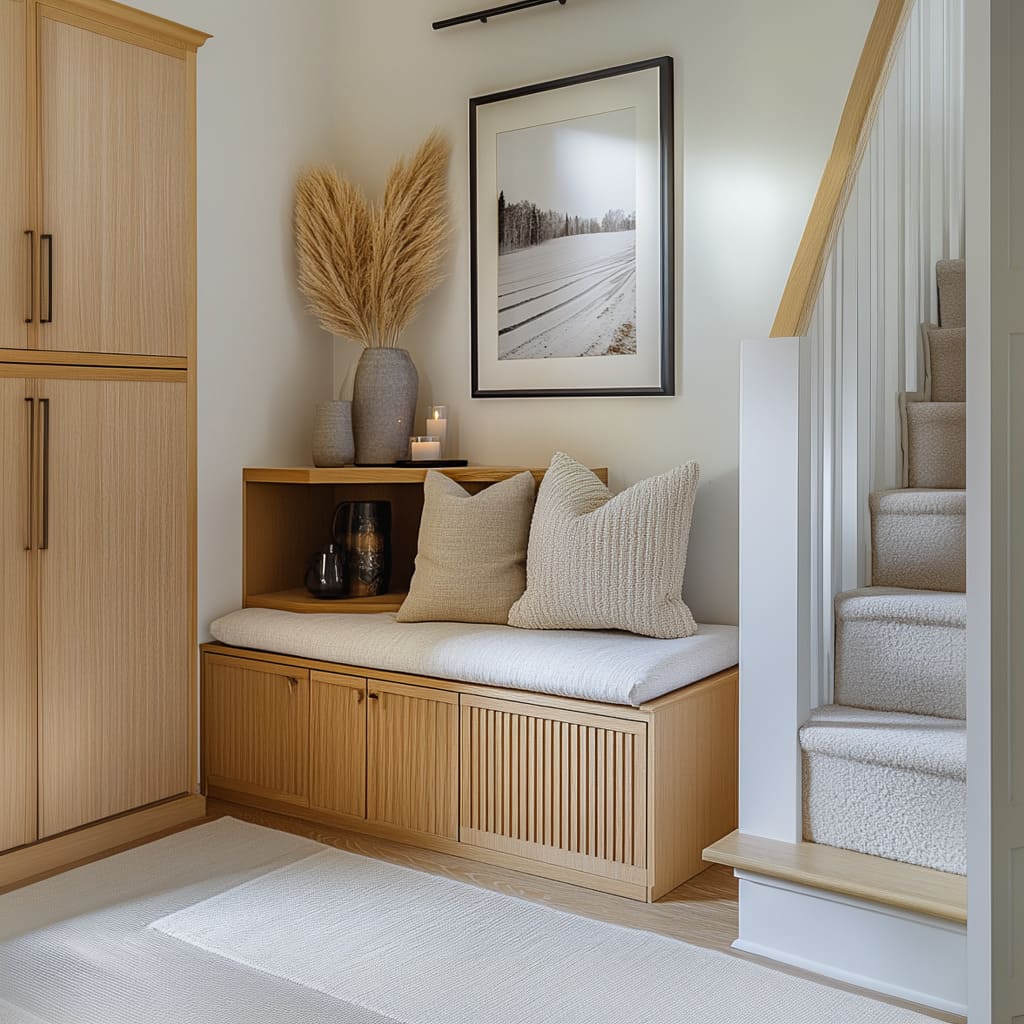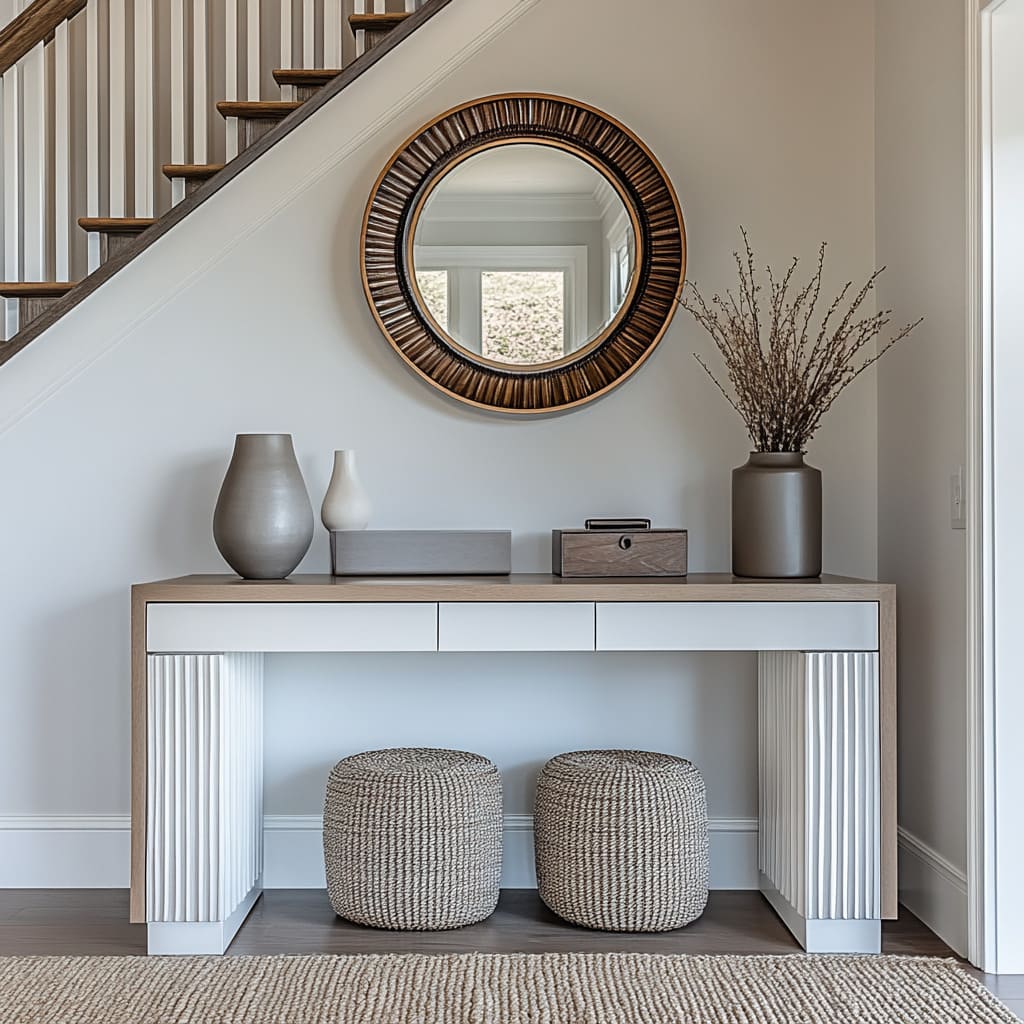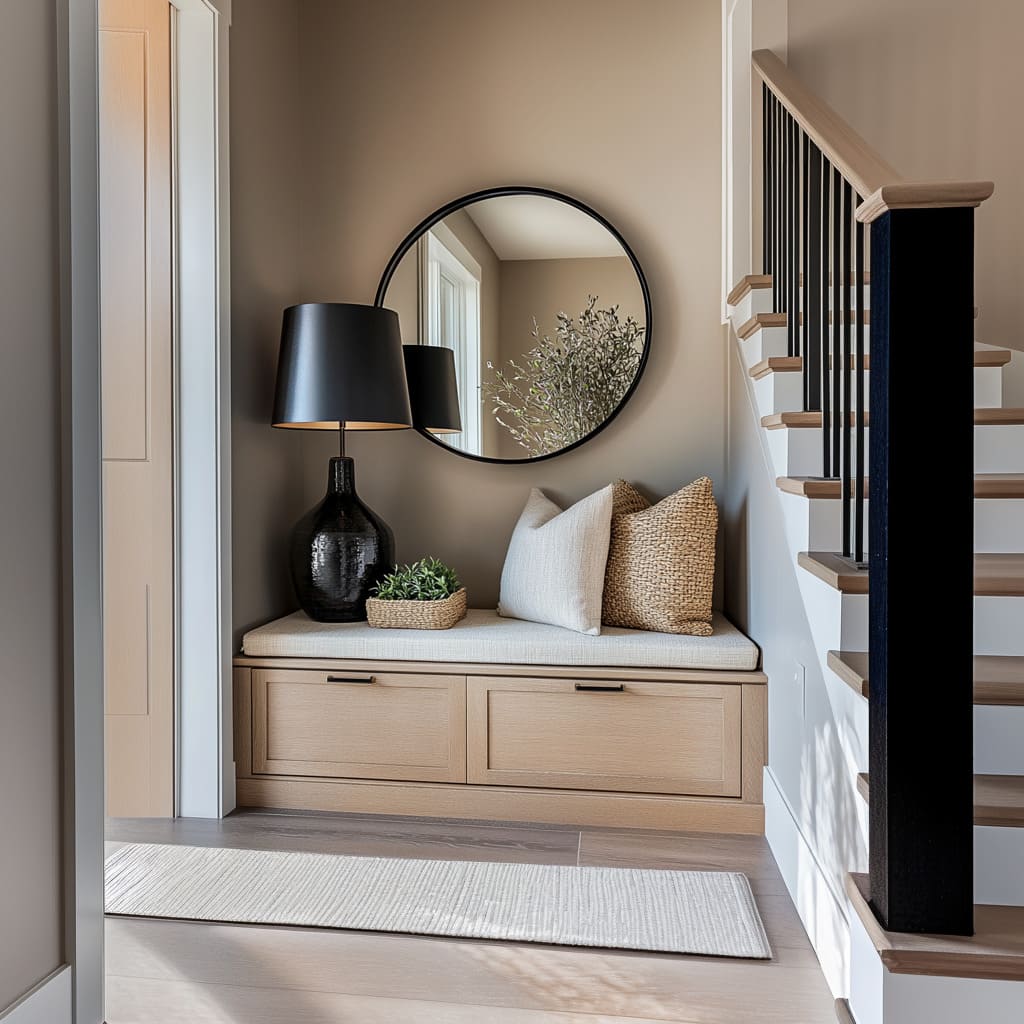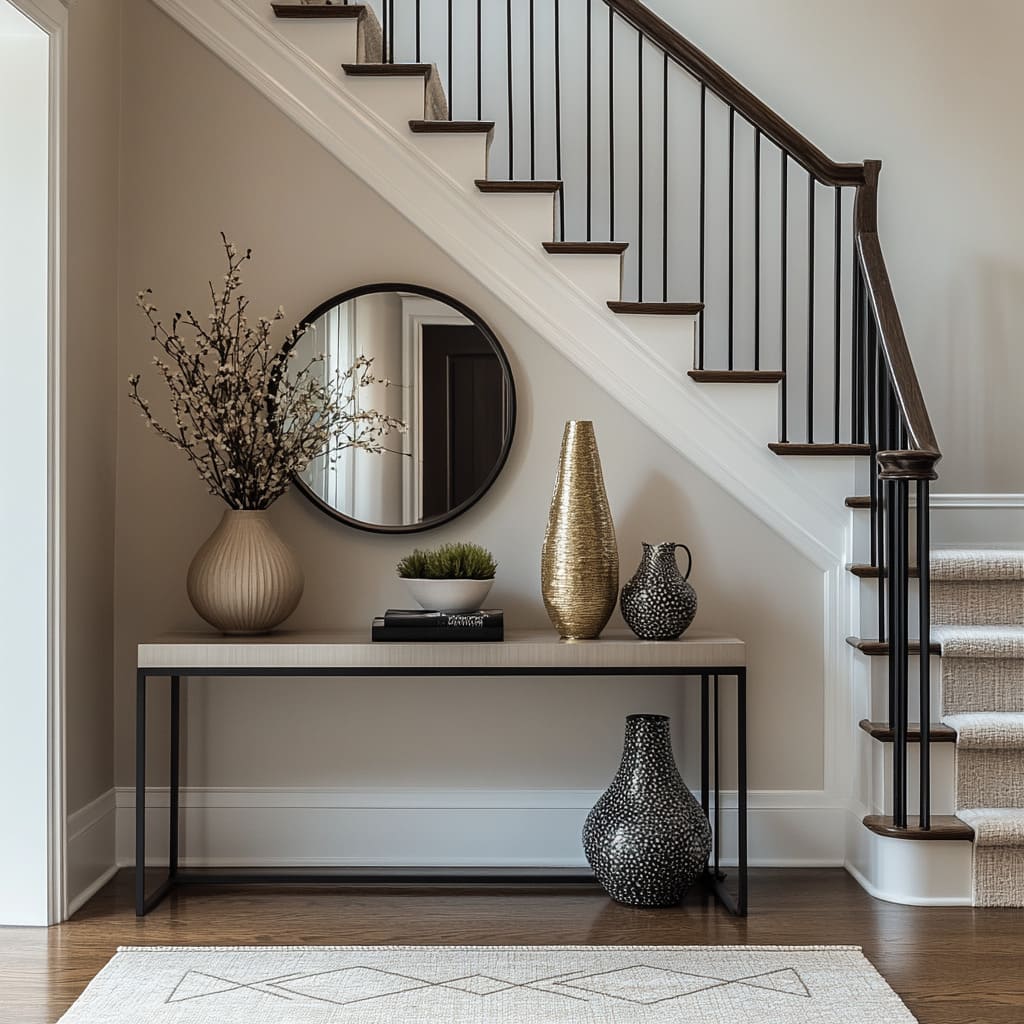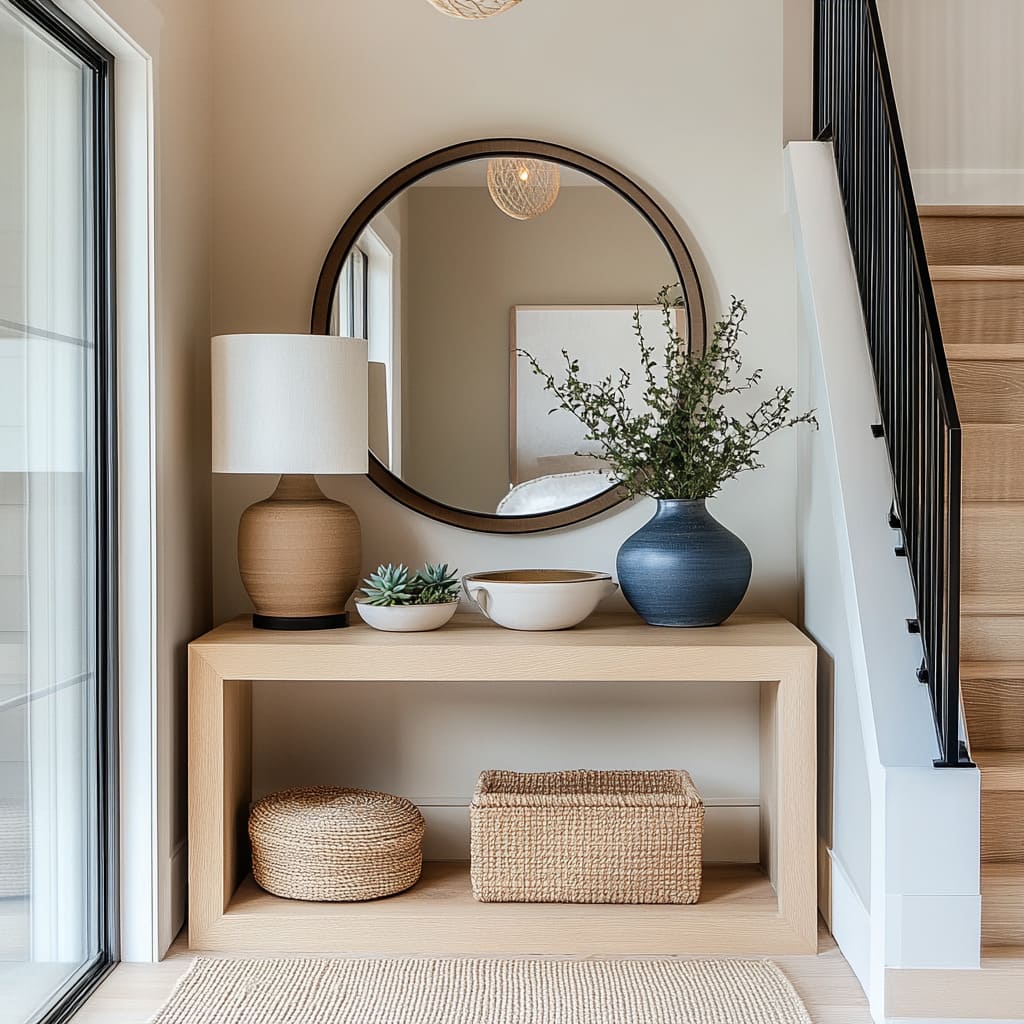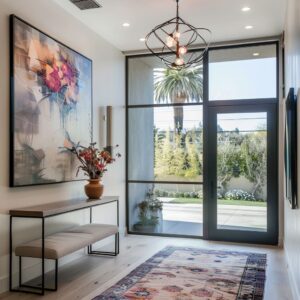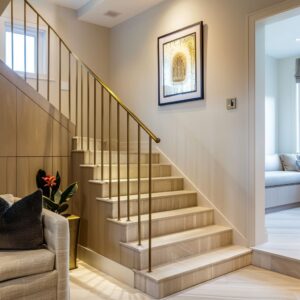In this article, we explore a variety of entryway decorating ideas that bring together functionality and style in a seamless way. Entryways, as the first impression of a home, deserve thoughtful attention, and the possibilities for design are as creative as they are practical.
From subtle contrasts in textures to smart storage solutions, the insights shared here aim to inspire readers with both timeless and innovative approaches.
Furniture and Storage Solutions
Bench-Integrated Storage
Benches with built-in storage options, such as cabinets, cubbies, or baskets underneath, are a standout feature for organizing entryways while maintaining a polished look. These versatile pieces combine functionality with design, making it easier to manage clutter without sacrificing style.
Whether used for shoes, scarves, or daily essentials, the concealed storage keeps items tidy while blending seamlessly into the overall decor.
A particularly intriguing idea is the use of cabinetry fronts featuring ‘X’ designs, reminiscent of farmhouse or cottage aesthetics. This detail not only elevates the appearance of these benches but also creates a subtle decorative layer that pairs beautifully with organic materials like woven baskets.
This mix of textures enhances the space’s visual and tactile appeal, combining the structured elements of woodwork with the softness of natural fibers. What makes these storage solutions even more versatile is their adaptability to different needs and spaces.
Some designs cater to bulkier items by incorporating enclosed cabinets, while others use exposed baskets for easy access. The latter creates a casual yet organized feel, perfect for family-friendly homes or smaller entryways where functionality takes center stage.
Console Tables with Display Opportunities
Console tables are a classic choice for entryways, offering both a practical surface and a decorative statement. Positioned against the wall, these tables create an ideal spot for layering items such as table lamps, framed art, and vases.
Beneath the surface, features like shelving or neatly arranged woven baskets expand storage possibilities, allowing for everything from seasonal accessories to daily essentials. A noteworthy detail found in some designs is the incorporation of decorative boxes on consoles.
These not only add a layer of sophistication but also provide discreet storage for smaller items such as keys, mail, or miscellaneous trinkets. The combination of style and utility ensures that the console table is more than just a decorative element—it becomes an integral part of a functional entryway.
When materials such as slatted wood or a blend of wood and metal are used, console tables bridge the gap between traditional and contemporary styles. This transitional approach creates visual interest while maintaining cohesion with the rest of the home’s design.
These versatile pieces adapt easily to various aesthetics, making them a staple in homes seeking both form and practicality.
Wall Decor and Mirrors
Mirrors as Focal Points
Ьirrors are a consistent feature in stylish entryway designs, serving as a cornerstone for both functionality and aesthetics. Their ability to reflect light and visually expand a space makes them indispensable in compact or dimly lit areas.
Beyond their practical benefits, these mirrors often double as a design statement, anchoring the entryway and drawing the eye. A fascinating aspect of these mirrors is the intentional choice of framing materials.
Natural finishes like wood or brass frames not only complement but also unify the entryway decor, seamlessly connecting them to other elements, such as benches or console tables. This harmony reinforces the overall color scheme or texture palette, ensuring the mirror feels integral rather than an afterthought.
Mirrors are frequently combined with thoughtfully placed lighting fixtures, particularly sconces. This pairing not only provides ambient lighting but also enhances the reflective qualities of the mirror, creating a layered glow that adds depth to the entryway.
Such combinations are practical and visually engaging, elevating the mirror’s role from simple utility to a centerpiece of the space.
Artwork
Artwork plays a pivotal role in crafting a visually rich entryway. Designs often feature botanical prints or abstract pieces, offering timeless appeal and a sense of refinement.
Minimalist line art is another popular choice, balancing the room with its simplicity and understated charm. These pieces often come in oversized frames, which deliberately amplify their presence and emphasize their role as a key design feature.
An insightful combination seen in many entryways is the pairing of monochromatic or neutral artwork with bold greenery. This contrast creates a captivating dynamic, as the calm tones of the artwork allow the vibrant hues of plants to stand out without overwhelming the space.
The result is a balanced and inviting look that showcases the harmony between natural and artistic elements. These hallway wall decor ideas highlight how carefully curated mirrors and artwork transform an otherwise utilitarian space into a cohesive and welcoming part of the home.
Whether your inspiration leans toward modern simplicity or a more eclectic vibe, these choices offer endless opportunities to personalize and enhance your entryway.
Flooring and Rugs
Practical Yet Stylish Flooring
Entryways frequently showcase light oak wide-plank flooring, a choice celebrated for its warmth and simplicity. This material aligns with Scandinavian-inspired designs, creating a soft and airy foundation for the space.
Alternatively, tile floors are a practical option in high-traffic entryways, offering durability and easy maintenance while still maintaining a sleek and polished aesthetic. These flooring types often set the tone for the rest of the home, blending function with an understated elegance.
A key insight in many entryway flooring ideas is the thoughtful incorporation of rugs. Woven or textured rugs bring a sense of softness and comfort to areas that might otherwise feel too utilitarian.
Positioned strategically under benches or in front of console tables, rugs help visually anchor these furniture pieces, creating a cohesive and balanced layout. This practical yet stylish layering not only enhances the flooring but also delineates the entryway from surrounding spaces.
Layering Textures with Rugs
An effective design approach is layering rugs over smooth floors, particularly in transitional areas. This method adds depth and character, helping to transform a straightforward entryway into an inviting and personalized space.
Layering works especially well with neutral-toned rugs that complement the color palette of the room while introducing subtle patterns or textures to draw interest without overwhelming the area. Combination plays a significant role here—pairing durable tile or wood floors with plush rugs creates a visual and tactile contrast, enhancing the welcoming feel of the entryway.
When choosing rugs, durable options like flat-weave or jute are favored in high-traffic foyers, while softer materials like wool work well in quieter spaces. These combinations highlight how foyer rug ideas bring together aesthetics and practicality seamlessly, creating a space that is both visually appealing and functional.
Accessories and Greenery
Greenery as a Connecting Element
A consistent feature in many entryway ideas is the incorporation of greenery, often in the form of plants or branches arranged in decorative vases. These natural elements soften the structured geometry of furniture and wall decor, creating a refreshing balance between hard and organic textures.
The greenery provides an approachable warmth, linking the entryway with the broader interior while adding a dynamic, lively touch.
A key observation is the use of tall, dramatic branches strategically placed in low-profile vases. This deliberate choice creates vertical interest, subtly emphasizing the height of the ceiling and drawing attention upward.
The balance between the height of the branches and the compactness of the furniture establishes a sense of proportion, preventing the space from feeling too confined or sparse.
Layered Accessories
Accessories such as books, ceramic pieces, and woven baskets are often layered into the design to add depth and personality. These elements are typically arranged asymmetrically, breaking up rigid patterns and introducing a sense of natural flow.
Subtle variations in the height and texture of these objects ensure the composition feels dynamic and curated rather than overly staged. Combination plays a critical role in the contrast of materials and tones.
For example, dark vases used for greenery create a striking juxtaposition against light furniture or neutral walls. This interplay not only makes the greenery more vibrant but also ties together darker elements like metal fixtures, frames, or textiles in the entryway.
These thoughtful combinations illustrate how accessories and greenery transform functional areas into visually engaging and harmonious spaces.
Lighting
Wall Sconces for Ambient Lighting
Wall sconces serve a dual purpose in entryway designs, providing functional illumination and acting as decorative accents. Positioned to highlight specific areas, such as mirrors or artwork, they enhance the focus of the space without dominating the layout.
Their design—whether sleek and minimal or ornate with intricate detailing—sets the mood of the entryway, blending seamlessly with the surrounding decor. A modern sconce paired with clean lines introduces sophistication, while a vintage-style fixture leans into a cozier aesthetic.
A unique insight lies in the alignment of wall sconces with other metallic finishes in the space, such as table legs, hooks, or frames. This consistency ties together different design elements, creating cohesion even in compact spaces.
Particularly in decorating ideas for small hallways, these fixtures play a pivotal role, as their wall-mounted placement conserves floor space while providing targeted lighting that prevents shadows from encroaching on already narrow areas.
Combination with Furniture and Decor
The placement of sconces above console tables or flanking artwork enhances their visual impact and ensures even lighting distribution, eliminating the need for overpowering overhead fixtures. Pairing sconces with reflective surfaces, like mirrors, amplifies light in the room, giving the illusion of a larger, brighter space.
The interplay between lighting and reflective elements is especially valuable in confined entryways, where maximizing light is key to maintaining an open, inviting atmosphere.
Pendant Lighting as a Statement
Pendant lights, on the other hand, bring a bold design focus to entryways. Often positioned to draw attention to the center of the space, they contrast with the subtler glow of sconces by emphasizing height and vertical movement.
Pendants can range from industrial-inspired designs with exposed bulbs to softer, dome-shaped styles that diffuse light evenly. This separation between the vertical drama of pendant lights and the horizontal focus of sconces adds a layered dimension to the room, making it visually engaging while remaining functional.
Lighting, when layered thoughtfully, transforms even the most basic entryway into a cohesive, welcoming environment. By pairing sconces and pendant lights strategically, it’s possible to balance ambient, task, and accent lighting, ensuring the entryway is as practical as it is visually pleasing.
Color Scheme and Material Combinations
Neutral Foundations
Neutral tones dominate entryway designs, with shades like white, beige, and light wood forming the backdrop. These colors establish a calming and timeless environment that can be adapted to various styles, from minimalist to rustic.
Neutral walls and cabinetry act as blank canvases, allowing decorative elements and functional items to stand out without overwhelming the space. This approach works particularly well for hallway spaces, as neutrals ensure versatility and compatibility with evolving decor trends.
A significant design principle observed is the balance between warm and cool neutrals. For instance, pairing white-painted furniture with soft gray or charcoal cushions introduces contrast that avoids a washed-out effect.
This dynamic prevents the space from feeling flat while maintaining a seamless aesthetic. Neutral foundations not only create a sense of continuity throughout the home but also allow for subtle shifts in tone to distinguish one space from another.
Combination of Finishes and Textures
Depth and richness in these entryways are achieved through contrasting finishes. Matte ceramics sit comfortably alongside glossy, reflective vases, creating subtle textural variation.
This method enhances the visual layers without complicating the color palette. Hard surfaces like polished wood or metal are softened with woven elements such as baskets or textured rugs.
These textural contrasts ensure the space feels inviting yet polished, striking the perfect balance between functionality and style.
Material Interplay
Repetition of textures within the same space is another hallmark of thoughtful entryway designs. For example, a woven ottoman might echo the texture of a nearby basket, subtly reinforcing a cohesive theme.
This repetition doesn’t feel redundant but instead strengthens the overall design by creating a subconscious sense of harmony. The pairing of woven materials with structured, hard surfaces like wood cabinets enhances visual interest, providing a tactile balance that feels both intentional and natural.
Ultimately, these color and material choices are designed to work with, rather than against, the structure and lighting of the entryway. By layering textures, mixing warm and cool tones, and repeating patterns subtly, these spaces achieve depth and cohesion.
This approach allows the entryway to transition smoothly into adjoining rooms while maintaining its unique character as the home’s welcoming focal point.
Clever Combinations
Height Play
Incorporating elements of varying heights is a standout feature in many entryway designs. For instance, tall branches elegantly arranged in ceramic vases create a sense of verticality, contrasting with the low profiles of benches or console tables.
This balance enhances the visual rhythm of the space, encouraging the eye to move upward and explore different focal points. In addition, taller pieces lend a sense of grandeur to compact entryways, making them feel larger and more open.
Dual Functionality
Entryways often embody practicality without sacrificing style. A notable example is the use of baskets tucked neatly under benches or alongside consoles.
These woven accents serve a dual purpose—they act as storage for shoes, scarves, or miscellaneous items while doubling as decorative pieces. This approach seamlessly blends function with aesthetics, ensuring that even the busiest spaces remain organized and appealing.
Such dual-purpose solutions stand out when brainstorming hallway ideas for homes where space efficiency is key.
Asymmetry for Interest
Asymmetry is a recurring theme in entryway arrangements. Whether it’s the placement of accessories on a console table or the alignment of wall art, the deliberate imbalance creates a dynamic, lived-in feel.
For instance, a tall vase on one side of a console might be balanced by smaller framed photos or books on the other, avoiding a formulaic layout. This method ensures each piece gets its own moment to shine without overwhelming the design.
Natural Elements
The consistent use of natural materials ties these entryways to biophilic design principles, creating a sense of harmony with the environment. Wooden furniture, greenery, and woven accents such as baskets and rugs bring warmth and texture to the space.
These natural touches soften the look of harder materials like metal or glass and foster a welcoming and tranquil atmosphere. This blend of textures ensures that entryways feel cohesive while maintaining an inviting, organic aesthetic.
In combining these principles—height, dual-purpose elements, asymmetry, and natural materials—entryway designs manage to be both functional and visually compelling. These clever strategies ensure that even the smallest spaces feel intentional and full of personality, showcasing the potential of thoughtful design.
How These Designs Work with Room Interiors
Transition Spaces
Entryways often serve as a gateway between the outside world and the comfort of the home’s interior. Far from being overlooked, these spaces play a significant role in setting the tone for the rest of the house.
These entryway design ideas prioritize a balance of functionality and style, creating an area that feels deliberate and inviting rather than purely transitional. By incorporating storage benches, mirrors, and well-chosen decor, entryways provide both utility and a welcoming ambiance that resonates with the home’s overall character.
Integration with Adjacent Spaces
Thoughtful entryway designs seamlessly connect to nearby areas, often through a cohesive use of colors, materials, or furniture styles. For example, the natural wood tones in an entryway bench might echo the finish of dining room chairs visible just beyond.
Similarly, wall decor in the entryway can subtly match the artwork in adjacent spaces, tying the home together visually. This integration ensures that the entryway feels like an extension of the living area, offering continuity and flow that enhances the overall interior design.
Light Amplification
Light is a key consideration in entryway design, especially for spaces that are narrow or lack natural light. Large mirrors amplify both natural and artificial light, creating a sense of openness and airiness.
Light-colored walls, flooring, and furniture further contribute to this effect, making even compact entryways feel expansive and inviting. The strategic placement of lighting fixtures, such as sconces or pendant lights, complements these reflective surfaces, ensuring the space is bright and visually engaging regardless of the time of day.
By combining these principles—purposeful design, cohesive integration, and effective use of light—entryways become more than just a functional necessity. They establish a welcoming first impression, introduce elements of the home’s aesthetic, and connect seamlessly with the spaces that follow, creating a unified and thoughtful interior environment.
Final Thoughts
These designs reflect a harmonious blend of practicality and style, transforming entryways into spaces that do more than welcome visitors—they make a statement about the home’s character. By carefully layering textures and playing with material contrasts, these entryway ideas demonstrate how design can enhance functionality while creating a warm, inviting atmosphere.
Whether through oversized artwork paired with understated benches or the combination of sleek hard surfaces with soft woven accents, these entryways prove that small spaces can pack a big design impact.
The thoughtful use of space in these designs ensures that every piece serves both an aesthetic and a practical purpose. Storage solutions, whether concealed or displayed, integrate seamlessly into the overall look, maintaining a sense of order while keeping essentials close at hand.
These features are especially valuable for homes seeking to balance day-to-day utility with an intentional, polished presentation.
What sets these ideas apart is their adaptability. Each design concept offers opportunities for personalization, whether through unique decor choices, creative lighting arrangements, or unexpected material pairings.
They invite homeowners to rethink how even a small space can express their style while serving their needs effectively. By embracing the principles of contrast, cohesion, and thoughtful detailing, entryways evolve from functional zones into memorable focal points of the home.
These designs inspire a fresh perspective on what an entryway can be—welcoming, efficient, and undeniably stylish.
